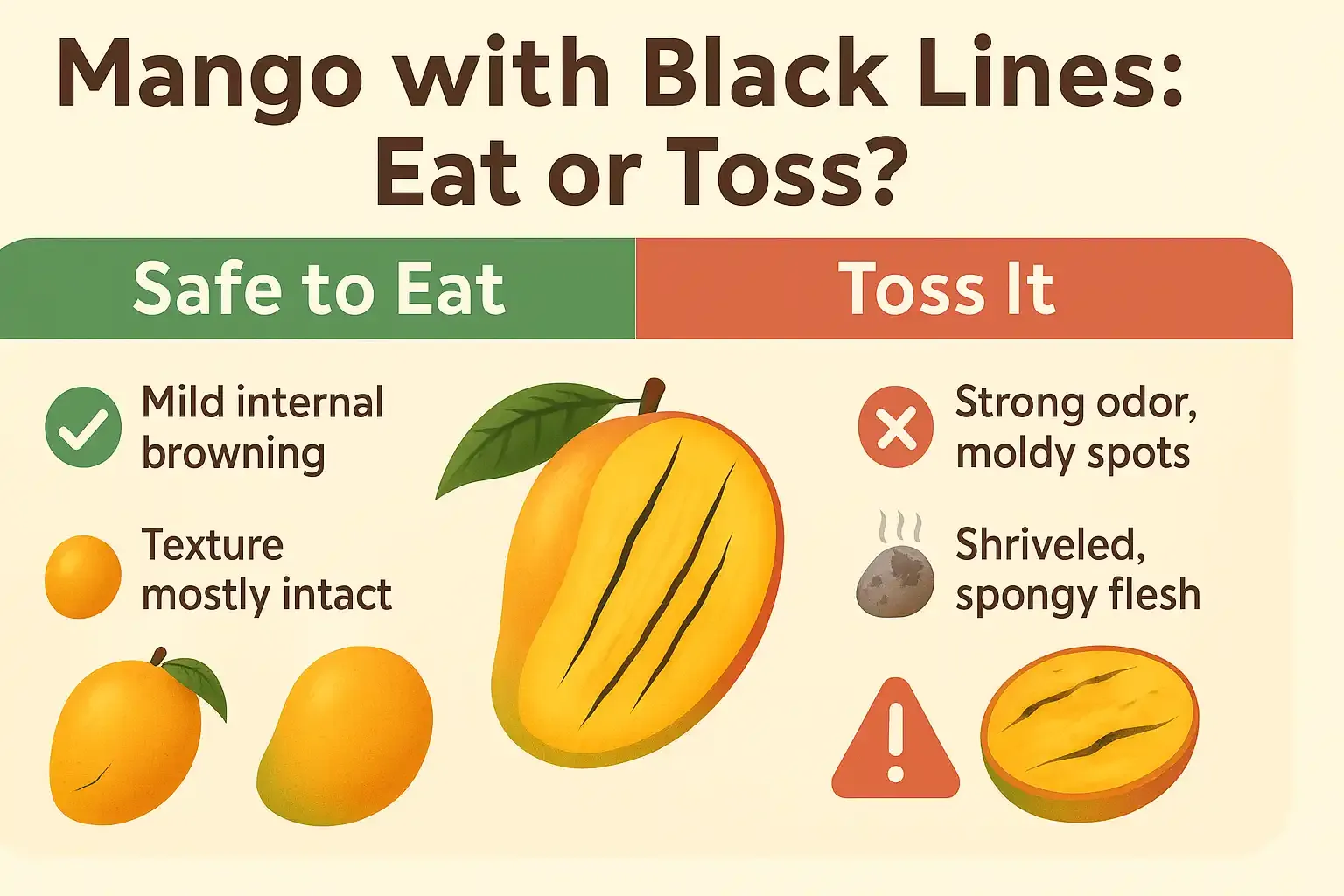Black lines are a natural phenomenon that occurs in the world's most popular fruit, mango. Is It Safe to Eat Mango with Black Lines is a big question that many of us have. If we were to answer in one word, the answer would definitely be yes.
You must have often seen that when you cut a mango, there are slight black lines on its flesh. This must have worried you. There are very few people who have not gone through such a worry.
What these black lines are, why they form, their causes, whether or not they pose a risk to our health, and how to determine whether a mango is still safe to eat are all examined in detail in this article.
Table of content
What Are Black Lines in Mangoes?
Black streaks in mangoes usually appear as dark lines or fibers running through the flesh of the mango. They can be very thin, thread-like, or slightly wider. They are mainly dark brown or completely black in color. In most cases, these marks are only visible internally. It is only when we cut a mango and look at it that we can see that such a problem exists.
These lines are occasionally referred to as:
- Internal browning
- Vascular streaking
- Sap streaks
- Fiber darkening
Black streaks may seem worrisome to you. but they don't always indicate damage or contamination to the mango.
Possible Causes of Black Lines
Black streaks on mangoes can be caused by a variety of natural or external factors. The most frequent causes are broken down here:
| Cause | Description |
|---|---|
| Natural Overripening | As mangoes become overripe, their internal fibers may darken and change color. |
| Sap Injury or Bruising | During harvest or transport, sap exposure or pressure may lead to internal streaking. |
| Fungal infection | Fungal diseases like anthracnose may cause internal discoloration or external black spots. |
| Bacterial contamination | Though rare, certain bacteria can affect the fruit's internal tissues. |
| Mango seed weevil infestation | A pest that burrows near the seed, occasionally causing internal damage and discoloration. |
| Internal breakdown | Post-harvest degradation due to improper storage or extended shelf life. |
Is It Safe to Eat Mango with Black Lines?
Whether or not it is safe to eat mangoes with black streaks depends on the source of the discoloration. We can divide it into two categories:
When It’s Safe:
- Lines are dry and isolated.
- The flesh smells sweet and fruity.
- Texture is firm or slightly soft, as expected in ripe mangoes.
- No mold, sliminess or foul odor.
In these situations, the black lines are probably caused by innocuous fiber darkening, slight bruising or ripening. The remainder of the fruit is usually safe. but if you're not sure, you can chop around any discolored areas.
When It’s Not Safe:
- The mango smells sour, fermented or off.
- The flesh is mushy, wet or slimy.
- There is visible mold inside or outside the fruit.
- Discoloration is spreading or appears alongside rot.
It is best to throw away the mango if you observe any of these symptoms. Fruit that has been spoiled may contain dangerous bacteria or fungi that should not be eaten.
Read also: Why Philippine Mango Is the Best
How to Tell if a Mango Has Gone Bad
Learning how to evaluate a mango’s freshness is essential. Here's a guide to help:
Visual Signs:
- Deep bruises or discolored spots on the mango skin.
- Black or gray mold near the mango stem or inside the fruit.
- Widespread black streaks are seen near the mango seed. It looks rotten.
Smell:
- A excellent mango smells sweet and delicious.
- It is beyond its best if it has a sour, fermented or alcoholic fragrance.
Touch:
- When gently pressed, a ripe mango should yield slightly.
- If it feels overly soft, wrinkled, or leaks juice, it's likely spoiled.
Taste:
- Safe mangoes taste sweet and rich.
- A taste that is sour, harsh or bubbly indicates spoiling or fermentation.
Tips for Choosing Good Mangoes
Whether you're at the market or the grocery store, choosing quality mangoes is the first step to avoiding problems like black streaks.
Look for:
- When gently squeezed, they give slightly, which indicates ripeness.
- Bright, consistent color without any noticeable dark areas.
- A fragrant, fruity smell from the stem end.
Avoid:
- Mangoes that feel overly soft or squishy.
- Wrinkled skin or bruised areas.
- Odorless mangoes (often underripe) or those that smell sour (overripe).
Storage Tips:
- Ripen mangoes at room temperature.
- Once ripe, refrigerate to extend shelf life by 3–5 days.
- Don’t store unripe mangoes in the fridge. it may delay or alter ripening.
Can You Use Mangoes with Minor Black Lines?
Absolutely. Mangos can still be used in a variety of ways if they are safe to consume and just have minor flaws. Here are some recommendations:
- Smoothies: Mix with milk or yogurt; the discolouration won't be noticeable.
- Chutneys or sauces: cooked preparations where texture and color aren't a big deal.
- Baking: use in muffins, cakes or fruit bars.
- Frozen treats: puree and freeze into popsicles or sorbet.
Just be sure to remove any mushy or spoiled parts first.
Expert View and Scientific Insight
According to food safety experts and horticultural experts:
- The slight discoloration that occurs in mangoes is often a natural byproduct of the fruit's aging or internal bruising.
- Not all defects impact food safety. In fact, many fruits with internal imperfections are discarded unnecessarily.
- You should not eat mangoes that are moldy or show signs of microbial damage, such as rot.
Studies from agricultural research institutions indicate that post-harvest conditions - ambient temperature and how you handle the mango - play a significant role in the appearance of internal black streaks in mangoes.
Final Verdict: Eat or Toss?
Use the following table as a quick reference:
| Condition | Safe to eat? |
|---|---|
| Dry black lines, normal smell, frim texture | Yes |
| Slight internal discoloration, no mold | Yes |
| Sour smell, slimy texture | No |
| Mold inside or around seed | No |
| Large soft spots with black streaks | No |
| Unsure about safety | No (Better safe) |
Conclusion
While the black lines on mangoes may seem alarming, the truth is that they are not always dangerous. These lines can occur for two reasons.
They are just signs that the mango is ripening. is partially ripe, or has undergone minor damage. You can use your senses to decide whether the mango is good to eat at this point. Trust your smell, touch and taste.
If you find that the mango smells good, tastes sweet, and has only a few harmless lines, then you can safely eat it. But if you are not sure or notice any signs of spoilage, it is always best to throw it away.
I hope this article has cleared up your doubts about Is It Safe to Eat Mango with Black Lines? Mango is delicious and nutritious, but only when it is fresh and safe.
FAQs
Q: Can black lines in mangoes be toxic?
A: No, most are not toxic. They’re usually due to aging or bruising. But if mold or rot is present, it’s best to avoid eating it.
Q: Do black lines affect the taste?
A: Slightly. The rest of the mango normally tastes good. but the affected portion may taste bland or fibrous.
Q: Are certain mango varieties more prone to this?
A: Yes. Some fibrous varieties or those grown in humid climates may show black lines more frequently.
Q: Can black lines appear after buying the mango?
A: Yes. Poor storage, high temperatures or physical damage after purchase can cause mangoes to turn brown internally.
Q: Should I report mangoes with black lines to the seller?
A: only in the event that they are accompanied by mold, spoiling or obvious contamination.
















0 Comments